Photos: Kip Miller
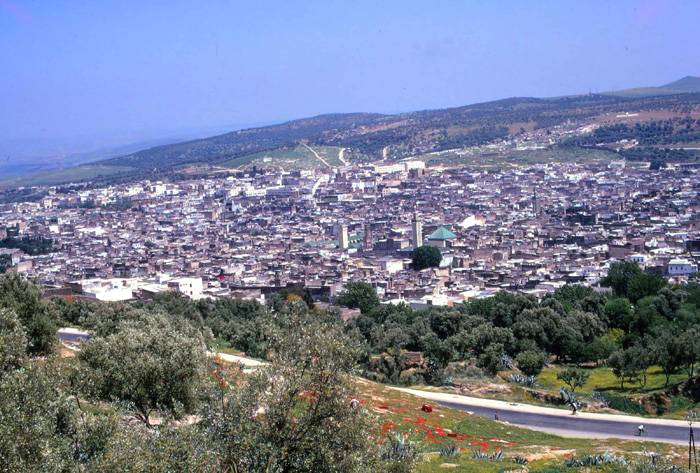
Fez, the world's most perfectly preserved medieval city, is tucked into the Middle Atlas Mountains
We have made surprisingly good time crossing the Sahara Desert. It's just past three on a cloudless May afternoon as we begin our approach the walled city of Fez. Known as the Athens of Africa, this historic metropolis ranks as a major center of Islamic learning, rivaled only by Mecca in Saudi Arabia. It is also the world's most perfectly preserved medieval city, famed for its vast car-free expanse. Fez is one of the oldest municipalities in Africa, dating from 859 and tucked amid the gentler slopes of the Middle Atlas Mountains. We pause on a hillside for a panoramic view of the city, wrapped in crenellated walls and renowned for its madrasas -- universities that were built when the city was first established. Lying behind these walls is a timeless medina, an old Arab quarter known as "Fez el Bali" and the earth's largest pedestrian area. Here, convoluted lanes trace the Oued Fez River and are virtually impossible to navigate without a local guide. Meant to be explored on foot, Fez's maze of lanes is honeycombed with dead ends and unexpected turns. Here, locals and tourists compete with donkeys and mules laden with vegetables, building supplies and assorted bric a brac. Here, too, the very air reeks, the scents of orange blossoms and spices competing valiantly with putrid aromas emanating from Fez's dye vats where a large array of dyes are spread out in ranges of hues.
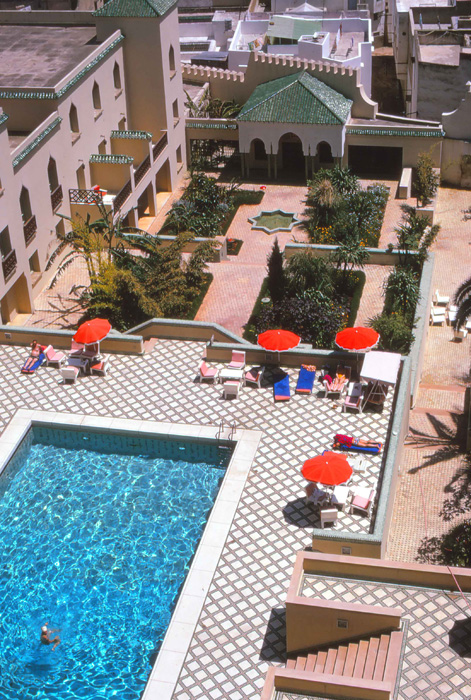
The Palais Jamais, once a vizier's palace, is now a luxury hotel with grand swimming pool and gardens.
We pull up at Bab Guissa, a gate leading to Palais Jamai, an opulent 19th
century palace hotel enveloped in manicured gardens with a sweeping view
of the medina beyond. "I sure hope we can get a room," I whisper
to my husband as we get in line behind several couples just checking in.
"Mais oui, Madame, nous avons une belle chambre por vous," says
the cheerful man at the desk. We follow a porter to a sunlit double room,
to be delighted by its size and magnificent brocaded drapes and bedspreads.
The porter speaks some well-rehearsed English, enough to relay a brief
history of the property. "This palace was built in 1879 by Si Mohammaed
ben Arbi El Jamai who was the Grand Vizier of Sultan Moulay Hassan Aziz
II," he explains. "Unfortunately, when the Sultan died in 1894
the Vizier's family fell out of favor with the new Sultan Abd El Aziz.
Two members of the family even landed in jail! The property was confiscated.
Some years later, the Palais was recovered by the family and later sold
to the Companie Generale Transatlantique. It was a very complicated sale
that took many years to finalize," he elaborates. "Finally,
by 1929 the details were complete and the Palais was transformed into
a luxury hotel. Be sure to experience our beautiful swimming pool and
dine at our El Fassia traditional restaurant. You will be impressed,"
the porter smiles convincingly as he departs.
El Fassia
is abuzz by 7 PM, with only a few vacant tables remaining. The soothing
scent of mandarin blossoms emanates from several dwarf orange trees potted
in traditional cobalt blue and white Fez jardinieres. "What are your
specialties?" I ask our solicitous waiter. "Everything,"
he says without blinking an eye. "But you will be especially pleased
with our salads. All the vegetables and fruits come from our very own
garden." "Exactly what I am in the mood for," I announce
excitedly. "Please bring out a nice selection of your best,"
my husband tells our waiter, "and some of your puffy flat bread,
I think it's called 'khobz,' and crispy 'msemen,' the one shaped like
a pancake." I am impressed by how much he has immersed himself in
Moroccan cuisine. In no time, the waiter brings out a large round tray
laden with nearly a dozen colorful salads and artfully arranges them on
our table. I am sorry to have left the camera in our room because this
garden feast is mind-blowing, and the tangy and refreshing tastes that
follow leave me on the verge of swooning: an orange and black olive salad
dressed in argan oil, a chopped tomato, cucumber and scallion salad flecked
with mint known as shlada, a tangy eggplant and garden tomato salad called
zaalouk, multi-color carrots dressed in vinaigrette and thyme with a hint
of red chili pepper, tender artichoke hearts with preserved lemons, and
several others. The breads are fresh and complement the garden tastes.
"The world would be a better place if the Moroccan palate were adopted
by more people," I declare as we head back to our room for a restorative
night's sleep. I drift off, delighted to be visiting a land where French
cooking has met its match.
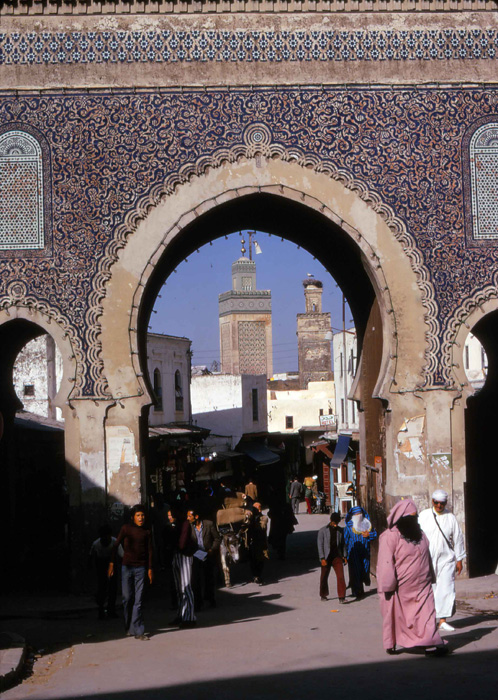
Bab Boujeloud, Fez's most important gate, dates back to 1913.
"It's going to be hot today," I smile at my husband as we pull into a designated parking spot near Bab Boujeloud, one of the main gates to the medina. "I am Salim," says a curly-haired boy in his best English. "You pay me only 10 dirhams. I watch car for you all day." "Why not," my husband agrees, happy to help the local economy. The gate dates back to 1913, a more recent entrance decorated in blue and gold tiles for Fez and green and gold for Islam. Just inside the gate a swarm of guides awaits visitors. We immediately realize we need a local to help us navigate the warren of narrow lanes and souks and to take us to Fez's important sites. A smiling young man pops out of a little café near the gate. "My name is Habib and I can show you all the important places in Fez. You pay me later what you feel is fair." Habib speaks excellent English and seems sincere enough. He takes us first to the Batha Museum just south of the entrance to the medina. Here we are regaled with several rooms that showcase a variety of Moroccan crafts, from rug-weaving and locally-made blue and white ceramics to brass etchings, jewelry and leather embossing.
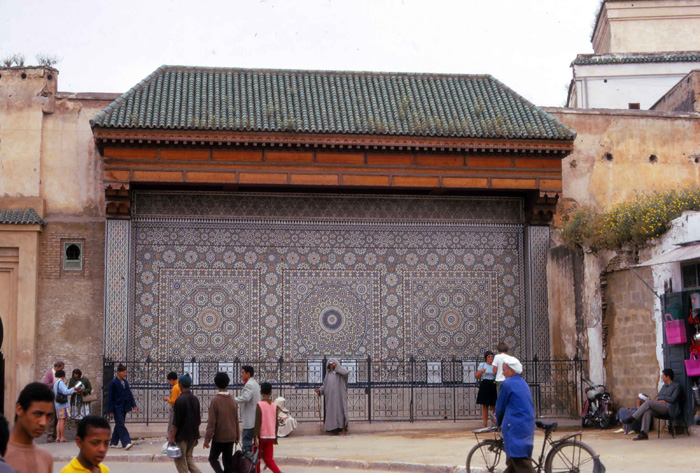
Talaa Kabira, one of Fez's main streets, is jammed with shoppers and donkeys laden with bric a brac.
Just inside the medina, a square splits into two main streets, the large
Talaa Kebira and the smaller Talaa Sqhira. It's a chaotic and fascinating
scene. I find myself constantly dodging donkeys and carts laden with every
imaginable item under the sun, from building supplies, mounds of oranges,
jars of olives, books and magazines to leather hides and small glazed
tiles. Nearby, on the upper part of Talaa Kebira, is an important monument
of old Fez, the Madrasa Bou Inania. A madrasa is an Islamic school that
once played a major role in Morocco, providing housing for students who
concentrated on religious studies. Madrasas have beautiful courtyards
decorated with lacy zellige stucco and carvings made from the abundant
cedars from the Middle Atlas region. "Bou Inania was built by Sultan
Abou Inan who gave up his debauchery to dedicate his life to one concubine
and the madrasa was meant to be evidence of his new piety," Habib
explains. "So beautiful is Madrasa Bou Inania that it is considered
a rival to our Kairaouine Mosque. In recent years, it officially evolved
from a religious institution to a modern university."
Fez is Morocco's oldest imperial city, a place where Hispano-Arab and even Jewish history and traditions took root. "It was a good place for a settlement because it lies at the intersection of two caravan routes stretching all the way from the Mediterranean and from the Atlantic to the Middle Atlas. We call it's the 'Athens of Africa,' because several emperors chose it to become the torch-bearer of the empire," Habib explains. I am quite taken by how much pride Habib has for his city. "The founder of Fez was a descendant of Mohammed named Moulay Idriss the Elder. He later became the enemy of all the Abbasid caliphs that followed because he participated in an uprising in Mecca. He had to flee. And in the course of his flight, he stopped on the right bank of the Fez River and established the first Moroccan settlement known as Madinat Fez." "When did the Jews arrive in Morocco?" I ask Habib as we trail behind him down a very narrow lane.
"Ah, that is a very long and complex story," Habib replies when we arrive at a small square. Jews had already been living in Morocco for centuries, but when they were expelled from Spain, great numbers arrived. By the way, 'Mellah' actually means 'salt,' which the earth in this section was filled with. The Jewish presence in Fez developed in stages, and never without hardship and violence," Habib observes. "So what else is new," I mutter to myself. "Since the Mellah was situated near the Royal Palace, it allowed the ruler to take full advantage of the community's special skills, especially their artisanal creativity and their commercial relations with other Jewish settlements in Europe," Habib elaborates. "Didn't Maimonides live in Fez for a while?" I ask. "Yes, indeed," Habib replies. "During his time here he continued his scientific studies and became an influential Torah scholar as well as a practicing physician. It was here that Maimonides completed his famous commentary on the Mishnah." We are both stunned by how much Habib knows about the Jews of Fez. Could it be that his family had some Jewish ancestors in centuries past? "Well, you know how the story ends," he continues in closing. "When Israel was founded in 1948, almost the entire Jewish community of Fez immigrated. Today only about 150 Jews remain in Fez, and most are quite elderly. That's quite a drop from the community's heyday when there more than 15,000 living in the Mellah and nearly 22,000 in all of Fez." I smile to myself, thinking about the injection of Morocco's food traditions into the newly formed Jewish state. How fortunate that culinary development in Israel pivoted away from the bland cuisine of the shtetls of Eastern Europe!
"We would be honored if you would be willing to join us for dinner," I smile at Habib, remembering our feast with our charming guide in Marrakech. "I would be delighted," he replies with a surprised smile. "Let me think about where we should go. Meet me again in front of Bab Boujeloud at eight. I will find us the perfect riad for dinner, and one that also has traditional music and dancing." "We must give Habib a very generous tip for all his time and effort," I remark to my husband as we head back to the hotel to rest and change clothes. "I would love it if he actually finds a place with live music."
Later at
a popular riad not far from Boujeloud, the three of us sit spellbound
as seven musicians dressed in flowing white djellabas play an array of
instruments including an oud, a ney, several darbuka drums, an hourglass-shaped
gimbas drum, and a Moroccan guitar called a sintir with an extra-long
neck. There is even a flute-like instrument that dates back to ancient
Egypt. A hefty woman dressed in white undulates effortlessly to the rhythmic
drums as she bursts into a wailing song, receiving immediate cheers from
the audience. The music is mesmerizing and the food fresh and delicious.
We eat on the light side, selecting a steaming mound of couscous with
local vegetables, followed by some sweet pastries, including almond crescents
and triangular briouats coated in fragrant honey. "We have a souk
right here in Fez that specializes in Middle Atlas honey. It's considered
the very best in all of Morocco," brags Habib. The entire day and
evening have exceeded our expectations and we reluctantly part company
with Habib after handing him a generous payment for providing us such
an exceptional time in Fez.

We head out toward the Sahara's moving sand dunes, hoping to experience a camel ride.
On our "must do" list for Morocco is to experience the Sahara's moving sand dunes. I've never mounted a camel and I understand it's quite something. We head out of Fez bright and early in a southeasterly direction through the arid desert landscape, past rows of towering palms toward Erfoud, only to be hugely disappointed when we arrive at the town outskirts. A uniformed official stops our car. "Speak English?" he asks. We nod our heads. "So sorry. You cannot continue. Road closed. We have a Grand Prix race today on this highway. It is starting in ten minutes." "Bummers," I grumble loudly for all to hear. "No sand dunes and camel rides for us!" "Oh well," my husband sighs. We speed straight back to Fez, in plenty of time to take in more of its sights: the Dar Al Makhzen Royal Palace and the magnificent gardens of Jardin Jnan Sbil, known for their manicured flower beds and unusual water features. Dating from the reign of Moulay Abdallah in the 18th century, the gardens span some 7.5 hectares laden with 3,000 species of shrubs and flowers, some unique to Morocco. We admire magnificent brass doorways and intricate tile work, the result of the painstaking artistry and ingenuity of local craftsmen. "Wow, there is no other country that I am aware of that can top this," I comment excitedly. By late afternoon, a sampling of sizzling Moroccan street foods tucked into just-made pita is a nice way to end the day.
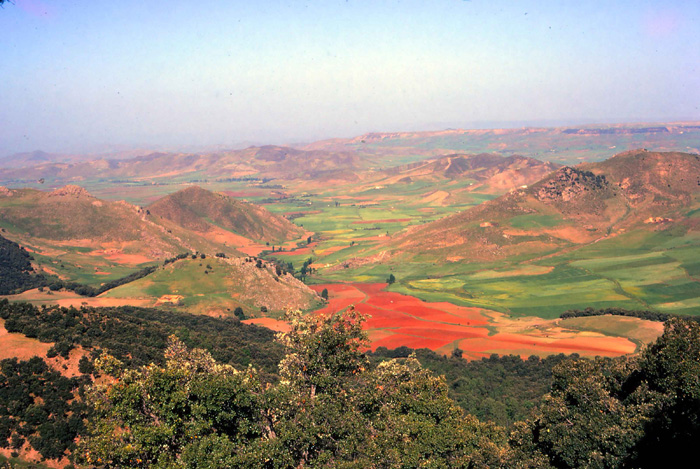
En route to Meknes, a vibrant landscape of green and red dazzles the eye.
Morocco's third imperial city, Meknes, is an easy drive from Fez, and we make an early start in the morning directly toward this historic place, renowned for its magnificent gates and sheep-shearing industry. The city spreads on a vast plain overlooking the Boufrekane River, smack in the middle between the northern Rif and the Middle Atlas Mountains. It was here in 1673 that Sultan Moulay Ismail chose to govern the country, lasting until 1727. His was an unusually tyrannical reign and his legacy is a 40-kilometer trail of walls that surrounds the medina punctuated by exceptional gates. Within the safety of the walls, the Sultan built a Royal Palace that was supposedly serviced by 60,000 slaves. The Sultan also had some 500 concubines, extensive granaries and thousands of horses. As we enter through the gates, I search for a local guide. A young man named Imran approaches us. "Only 50 dirhams, I show you everything," he offers. We nod our heads and follow him through three sets of walls, past the Royal Granaries and Haras Regional, the elaborate stables that house Morocco's purebred Arabian horses. "This is Bab Mansour, our most beautiful gate," points Imran. And magnificent it is, probably the finest portal in all of Morocco. At Bab el Khemis we stumble upon an enormous wool market where dozens of sheep are being shorn and huge piles of wool are available for sale.
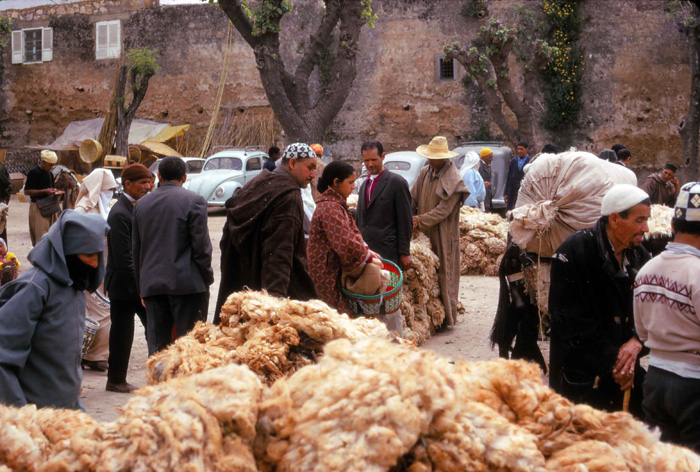
Piles of newly-shorn sheep wool are for sale at the Meknes's Bab El Khemis market.
Only minutes away is a shrine known as Zaouia of Side Mohammed ben Aissa,
once the revered sanctuary of the Aissaoua cult. "The people who
worshipped here had very strange rituals," Imran explains. "They
swallowed live scorpions and broken glass, ate live sheep and poisonous
plants." "I don't need to hear any more," I mutter as I
rush ahead on my own. Apparently, this cult is still quite a force in
Morocco, attracting thousands who gather from all over North Africa to
participate in its feast days in early June. Here snakes are charmed and
people break into trances that imitate the movement of animals. This feast
is called a moussem and ordinary locals and tourists are gobsmacked as
they witness its outlandish rituals and exotic dances. It ranks as one
of Morocco's most unique and astonishing events.
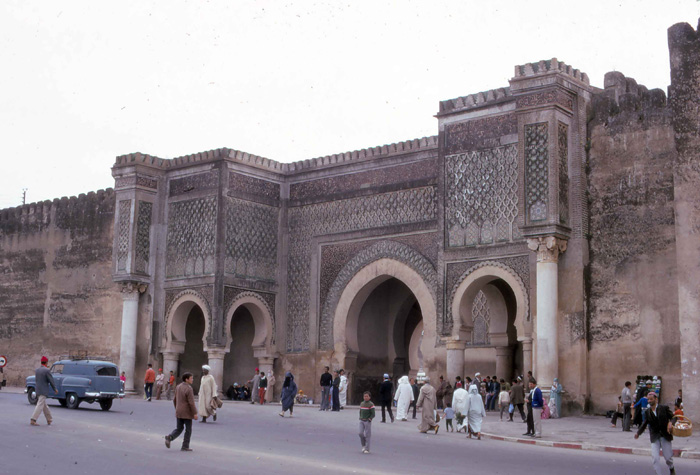
Sultan Moulay Ismail surrounded Meknes with magnificent gates.
Near the magnificent Bab Mansour gates we pause by Moulay Ismail's mausoleum and a large complex known as "The Prison of the Christian Slaves." Imran bids us farewell and we continue on our own past enormous stalls laden with piles of tagine cooking vessels next to a food souk with mounds of green and black olives, and heaps of turmeric, cinnamon and sumac. The food area morphs into a woodworker's market, followed by tiny workshops for ronsmiths, basket makers, and leather craftsmen, ultimately evolving into a colorful flea market. "Let's find a hotel before we continue to the outskirts of Meknes," my husband suggests. We park our bags at the Hotel Transatlantique which overlooks Meknes from across the river. Numerous foreign tourists are lounging around its spacious pool and we look forward to some poolside relaxation in the evening.
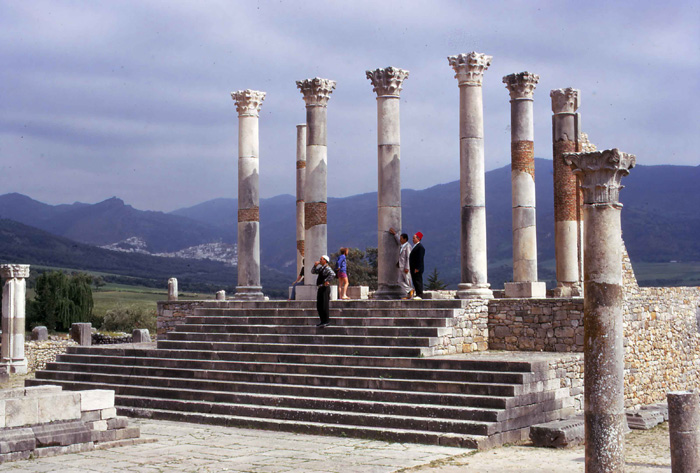
Elegant columns are a proud vestige of the city of Volubilis, the farthest incursion of the Roman Empire into North Africa.
Since there is much to see in the environs of Meknes, we head out in early
afternoon past the whitewashed town of Moulay Idriss, an important pilgrimage
place, toward Volubilis, once the capital of the Roman province of Mauritania.
The town marks Rome's farthest incursion into North Africa. It is laid
out in typical Roman municipal plan, a classic example of Roman urban
planning with well-preserved mosaic floors and a lineup of elegant columns
that are testimony to the architectural grandeur of the site. "It
was here that Caesar and Cleopatra's son, Juba II, lived with his wife,
Cleopatra Selene. Many remarkable treasures were found here," says
the guide at the site. "You can see them in Rabat's Archaeological
Museum." "Volubilis once was home to 20,000 people," he
continues. "There was a large triumphal arch here, but it collapsed
during the great Lisbon earthquake of 1755. There was even a brothel here,
the Lupanar. You can still recognize it by its giant stone phallus."
We linger in stunned silence, taking in the magnificent views, awed by
Rome's mighty reach into the entire Mediterranean. By early evening back
in Meknes, our hotel pool area is abuzz with guests, and attentive servers
are happy to bring us classic fare such as Croque Monsieur and Quiche
Lorraine followed by a platter of just-picked fruit.
Rabat, located
on the Atlantic coast, is Morocco's fourth Imperial City. It reigns as
the modern capital of the country. Its grand palace is also the king's
official residence. The city boasts wide boulevards, multi-storied department
stores and luxury apartments, but also a large traditional medina with
colorful souks. We are delighted to find a room at the Tour Hassan, a
modernized hotel that incorporates traditional architectural details and
a large interior Andalusian garden with numerous walkways and flower beds.
The concierge hands us a map of the city and proudly recommends his very
favorite restaurant for dinner. After a leisurely afternoon nap, we find
ourselves being led by a guide standing at the edge of Rabat's medina
toward Dinarjat, famed for native cooking that ranges from piquant salads
and crunchy bastilla to aromatic couscous topped with garden vegetables.
Meals here taste all the more authentic to the strains of rhythmic Andalusian
and Berber music.
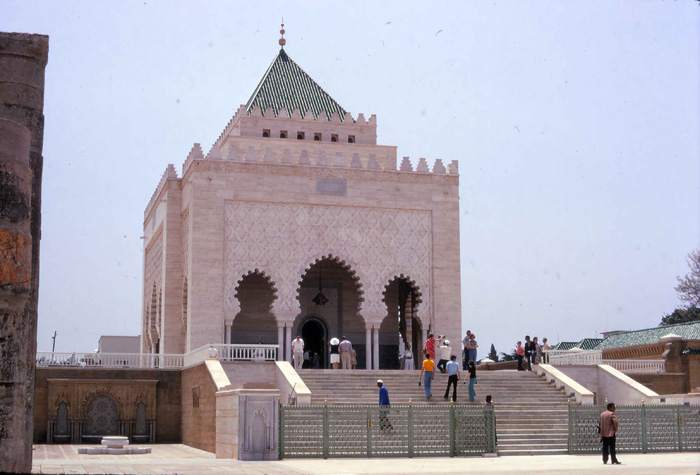
The Mausoleum of Mohammed V is Rabat's most visited site.
It's a cloudless Atlantic coast morning. We follow the recommendations of the concierge and begin our exploration of Rabat with the Mausoleum of Mohammed V, the city's most visited site and only completed in 1971. The approach takes us through a sea of columns, remnants of a ruined mosque. Straight ahead rises a platform surrounded by porticos of Moorish arches. A handsome guard nattily dressed in white stands sentinel, regaling us with a great big smile as we approach. Inside are several royal tombs and plenty of visitors gaping at all the architectural details. Next on our itinerary is the The Chella, a fortified Muslim necropolis dating from the Middle Ages. It was here that the Phoenicians first established a trading post in the third millennium BCE. We walk among its extensive Roman ruins and royal tombstones wondering who could be buried here. At Hassan Tower, another must-see monument, we find ourselves gazing at an unfinished structure that is eight centuries old. The scene suddenly comes alive as dozens of school children and their teachers arrive and sit in rows on the ground. The children are spellbound as the teachers take turns reenacting the multi-layered history that took place at the Tower. I am quite impressed by how well-behaved and attentive the children are. "Our American school children should take note. This is how one can learn with pleasure," I comment to my husband. We make a final stop in front of the entrance to the Royal Palace. "I understand the Royal Family spends a good bit of time here,"' I comment. Several nearby streets are dotted with embassies and consulates from other countries. "Over two million people live in Rabat," the concierge had told us. The city is known as Morocco's version of Washington, DC.
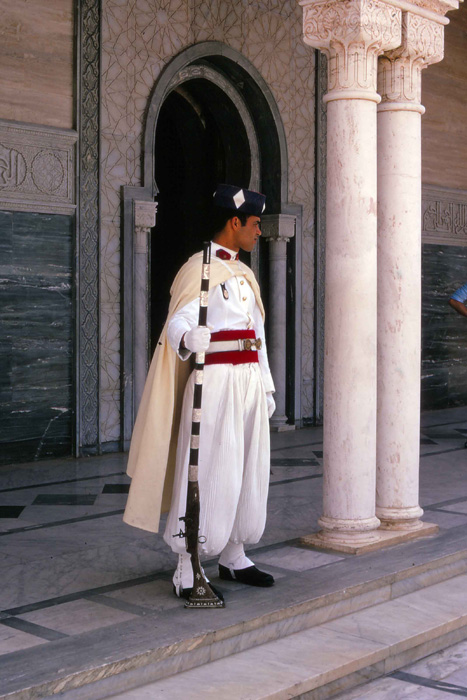
A dashing royal guard is about to regale us with a smile.
After a couple of nights in Rabat, it's time to go home. The drive to Casablanca is short, but we run a traffic light on the way to the airport. An officious policeman gnarls at us, but ultimately allows us to continue when we anxiously wave our passports and return tickets at him. It has been a remarkable journey to a land like no other. Its exoticism, cuisine and layered history, its spectacular mountain ranges and deserts, will forever be imprinted in our memories. "I can't wait to share this trip with friends and family," says my husband as we climb the staircase to the plane. I smile back at him, knowing how many hundreds of photos he took.
